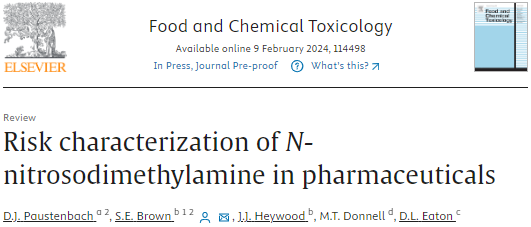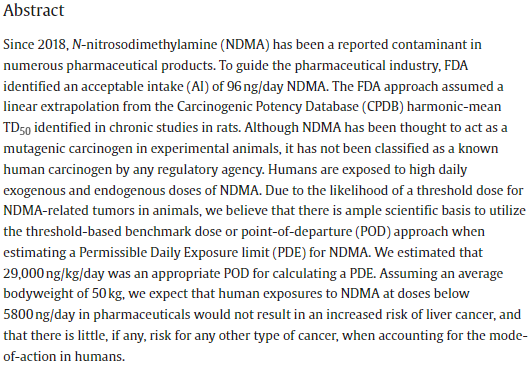![]()
The start of something we have all been waiting for?
I have read the full version of this now (warning - it is a long read) - but as a chemist it is absolutely fascinating.
I have to admit that up to now I have been nearly 100% focused on the formation of nitrosamines (and trying to stop the formation), and not what happens in the body.
This has opened up so many questions in my mind, which someone with much better knowledge may be able to help answer.
"Is this only applicable to NDMA currently due to:
- Availability of suitable data for other nitrosamines, including doses below which there appears to be no additional risk?
- Mutagen producing capability of different human CYP enzymes with different nitrosamines? NDMA is the simplest nitrosamine to model from the data provided, as it is only impacted by CYP2E1.
The reaction scheme for the reaction of NDMA with enzyme CYP2E1 shows a rough 2/3 α-hydroxylation : 1/3 denitrosation – is this the same with all of the CYP enzymes, or does this vary from enzyme to enzyme? Does a different enzyme produce more or less of the α-hydroxylated product? Does it also vary from nitrosamine to nitrosamine?
In the α-hydroxylation of NDMA there are only 2 CH3 groups, and whichever is hydroxylated makes no difference to the products that are formed. For the majority of other nitrosamines the 2 groups are not going to be identical, and therefore there are going to be 2 different possible products. What will influence which side of the nitrosamine will be hydroxylated (assuming an α hydrogen on both sides – if there is only one α hydrogen then you will know which side the reaction will take place)? Will it be a mixture? What then is the impact on the toxicity/mutagenicity of the NDSRI?
Can β-hydroxylation take place, followed by α-hydroxylation, and lead to even greater number of potential diazonium ions?
Does MGMT work just on methylated DNA or is it the same repair mechanism for all adulterated DNA? Yes it can – but the longer the chain the lower the repair efficiency - DNA Alkylation Damage by Nitrosamines and Relevant DNA Repair Pathways - PMC (nih.gov). Does this then mean that the formation of a smaller nitrosamine is actually preferential from a repair perspective, and a methyl diazonium ion is the best to have formed, providing you don’t swamp the amount of MGMT?"
Indeed it appears to be a fascinating article, haven’t time yet to read it in depth, but found it provoking and thoroughly documented.
@MarkS no kidding about ‘long reading’…
Sharing summary highlights from the paper:
• The current Acceptable Intake (AI) of 96 ng/day for N-nitrosodimethylamine (NDMA) in
pharmaceuticals was calculated based on the assumption of a linear dose-response
relationship between NDMA and liver tumors in rodents.
• However, there is a high likelihood of a threshold-based dose-response relationship
between NDMA and tumors in animals, and in humans, due to NDMA’s mechanism of
action, and DNA repair mechanisms.
• The weight of evidence suggests that human exposure to the concentrations of NDMA
that may be present in contaminated pharmaceuticals is not likely to pose any significant
increase in lifetime cancer risk in humans.
• It has been estimated that humans are exposed to up to 1,000,000 ng/day NDMA via
endogenous production alone.
• Due to the likelihood of a threshold dose for NDMA-related tumors in animals, we
believe that there is ample scientific basis to utilize the threshold-based benchmark dose
or point-of-departure (POD) approach and estimate a Permissible Daily Exposure limit
(PDE) for NDMA in pharmaceuticals.
• We calculated a PDE of 5,800 ng/day NDMA in pharmaceuticals, and expect that human
exposures to NDMA at doses below this amount would not result in an increased risk of
cancer.
It is so worth the full read though @Naiffer_Host
Thanks for providing the summary for everyone - my brain was off on the implications of it, were this to be accepted by authorities.
Indeed, the article is quite lengthy.
What I’d like to emphasize is the discussion the authors bring regarding the difference between the approach used in determining the Acceptable Intake of NDMA, which is based on the harmonic mean of TD50 values from various studies, and the approach recommended by the ICH M7, which suggests deriving the AI from a single robust study.
Another key point is the mention of a possible non-linear dose-response threshold between NDMA and liver tumors in rats. This suggests that lower doses of NDMA may not pose significant adverse effects, which has important implications for establishing safe exposure limits.
Furthermore, the article highlights the importance of considering the mode of action and DNA repair mechanisms in the risk assessment of NDMA. This underscores the need for a comprehensive, evidence-based approach in characterizing the risk associated with this substance.

